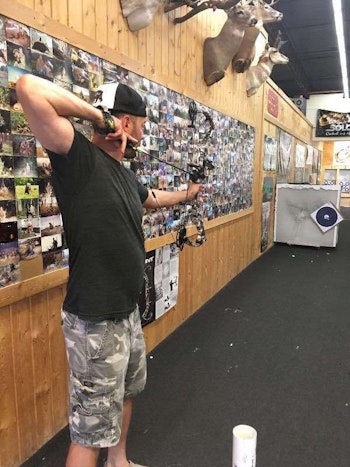
Through decades of shooting a bow, the author has developed an effective system for ending a shooting slump.
Back in the day, I was a decent baseball player — I played in college, made an all-conference team, stuff like that. Then I played open division fastpitch softball for a decade, traveling the country and playing with some of the world’s best. As such, I had to be a good hitter. But like any hitter, slumps are inevitable. There are times when things just quit going right, the frustrations build to a crescendo, and your eyes feel like they’re going to pop out of your head. But you work through it, and pretty soon you’re back to making solid contact again.
My experiences as an athlete were a great help to me when I started seriously shooting a compound bow. Like hitting a baseball, shooting a bow is an athletic discipline requiring a solid foundation built on a mastery of fundamentals, but also requiring mental discipline. As the years have rolled by, I’ve found that upon occasion my bow shooting dives into a funk, and I just can’t seem to hit the bull’s-eye as consistently as I should. I’m in a bit of a slump.
I sometimes hear it referred to as “target panic,” but I’ve never thought of my infrequent slumps as any sort of panic. I’m just off my feed, and need to get to work to correct my mistakes. Here’s how I work through it.
Just like in baseball, the majority of the time a slump isn’t due to improper mechanics or a physical deficiency – though they can be. More often than not, it all starts with your thoughts and visualization before you even draw back the bow. You become your own worst enemy. As legendary Yankees catcher Yogi Berra once famously said, “Baseball is 90 percent mental, and the other half is physical.” You have to stay positive as you work through your mechanics and visualize success, meaning that before you come to full draw, in your mind you have to visualize the arrow drilling the center of the target.
First Things First: Gear Check
But before I step back out on the range, I carefully check my equipment. Are all the screws on my bow tight? Is the sight loose? Has my peep slipped up or down the string? A compound bow is a complex machine, and as such requires regular maintenance to make sure everything is working properly. I spin-check my arrows to make sure they are perfectly straight. Once I’ve gone over everything, I can eliminate equipment failure as part of the problem.
Okay, if my gear is good, then it must be me. Time to recheck my shooting form. With my eyes closed in front of a mirror, I’ll come to full draw and anchor, then open my eyes and check myself out. (No arrow, so be sure to keep your finger behind the trigger.) Is my body and head position correct? Am I anchored in the right place? Can I see my sight pins through my peep sight without having to move my head? Is my bow hand position correct, and am I not holding the riser in a death grip? Check.
Now it’s time to work on releasing an arrow. This I also do with my eyes closed. With a large target 5 yards in front of me, I draw the bow, anchor, close my eyes, relax, then release. I shoot a wrist-strap, index-finger style trigger release, which I squeeze exactly as I squeeze a rifle trigger. While I hear people say that you should be surprised when the sear breaks and the arrow is released, I find this doesn’t work for me. I want to know exactly when my release cuts the shot. I adjust the trigger so that the pressure required is exactly where I like it. Just like shooting a rifle, I try and cut the shot between heartbeats, so my beating heart is not bouncing my sight up and down.

Good to go? Move the target to 20 yards and take a shot, focusing on your mechanics. I have a simple five-step mental checklist before I draw back on an animal. (And all my bow shooting practice is geared toward shooting animals – not being a champion target archer.) Pick a spot. Breathing control. Draw and anchor. Release. Follow through.
At this point, it’s process over results. If the arrow misses the bull’s-eye, that’s fine. I shoot one arrow at a time, walk to the target and pull it, and walk back before shooting again. This helps keep me from rapidly shooting bad arrows, which will, as golfers like to say, “groove a bad swing.” When I start grouping arrows tightly, I can adjust my sight if the hits are a bit off target.
Be Patient
This is not a single-day process. Instead, it’s shooting a few arrows at a time over several sessions over several days. Once I feel like I’m back to normal, I start shooting longer distances, building both my skill and confidence levels simultaneously.
It’s vitally important to have confidence when a big game animal is in range. Even after nearly 50 years, when a whitetail doe starts walking into range and I know I’m going to shoot her, my heart rate elevates and, when I’m sitting, my left leg starts trembling. Now that’s what I call target panic! So that’s when I go to my mental five-step checklist, and make the shot. I know I’ve gotten over the yips during my practice sessions, which has affirmed the fact that my setup is perfectly tuned, my arrows are flying like laser beams, and it’s sighted in precisely. All I have to do is focus and get it done.
It's 90 percent mental, and the other half is physical, right?





